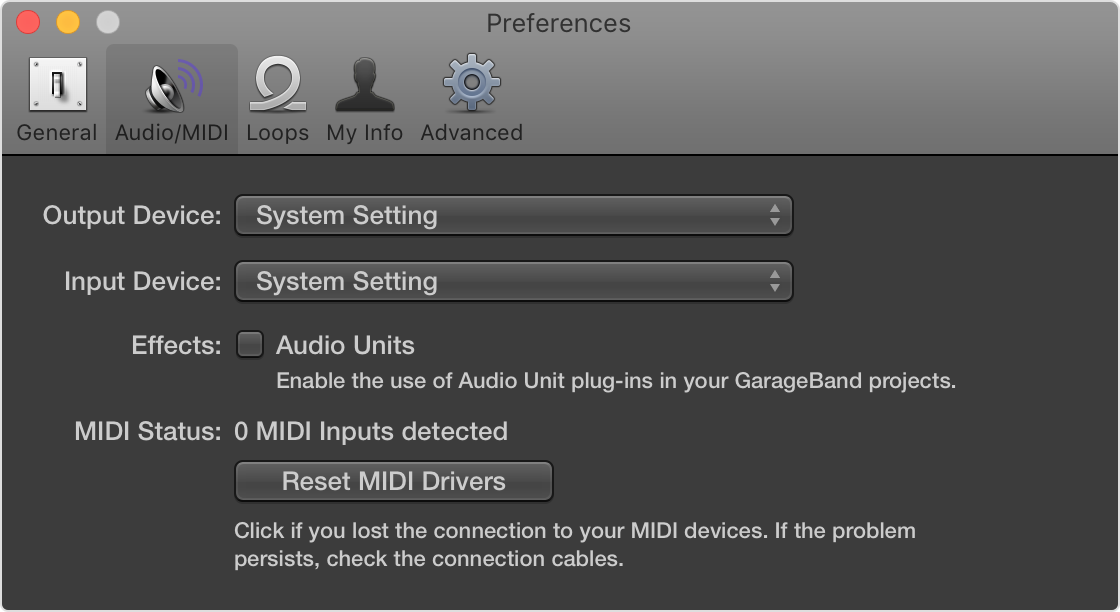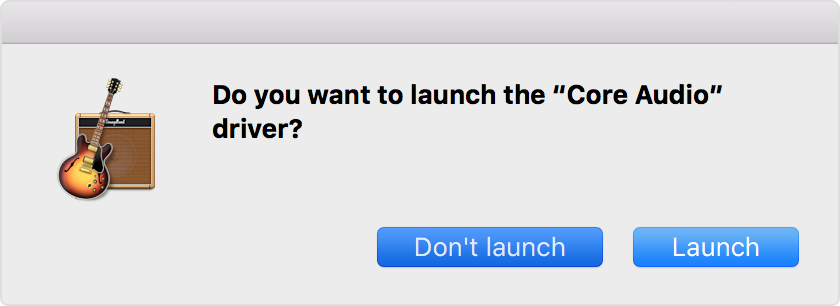If GarageBand isn’t working on your Mac
Find out what to do if GarageBand on your Mac won’t open, you can’t play or record in a project, or you’re having another issue.
Try these steps in order
Restart your Mac
Choose Restart from the Apple menu .
Update GarageBand
Choose Apple menu > App Store, then click Updates in the toolbar. If a GarageBand update is available, click the Update button to download and install it.
Check device or software compatibility
If you’re using an external audio interface, MIDI interface, storage system, control surface or plug-in not made by Apple, make sure it’s compatible with the latest version of GarageBand. Contact the manufacturer for support. If an update is available, follow the manufacturer’s instructions to update the device or software.
Use built-in audio with GarageBand
If you’re using an external audio interface, try using the built-in audio on your Mac instead of the interface.
Unplug your external audio interface from your Mac.
Open GarageBand, then choose GarageBand > Preferences > Audio/MIDI.

Choose Built-in Output from the Output Device pop-up menu.
Choose Built-in Microphone (or Built-in Input, depending on your computer) from the Input Device pop-up menu.
Open and play back a project that has been experiencing issues.
If the project opens and plays back properly, you might need to update or service your audio interface. Contact the manufacturer for support.
Open GarageBand without audio input and output
Open GarageBand and immediately press and hold the Control key before a project opens.
In the alert, click Don’t Launch.

If GarageBand opens, it can indicate the following:
You might need to update or service your external audio interface. Contact the manufacturer for support.
An Audio Units plug-in might be damaged or it might not be compatible with your version of GarageBand. Disable plug-ins to further troubleshoot your issue.
Disable Audio Units plug-ins
If you're using Audio Units plug-ins, try disabling them. Damaged or incompatible Audio Units plug-ins can create unexpected behaviour in GarageBand.
To disable Audio Units plug-ins:
Open a project in GarageBand.
Go to GarageBand > Preferences > Audio/MIDI, and deselect Audio Units.
Play back a project that has been experiencing issues.
If the project opens and plays back properly, a plug-in you're using in the project might be damaged or incompatible with your version of GarageBand. Check with the manufacturer of the plug-in for support.
Test with a new project
You can create a new project and test to check if the issue is with your project or with the GarageBand app.
If GarageBand is open, quit the app.
Open GarageBand and choose File > New.
Choose Empty Project in the New Project window.
Add audio files or Apple Loops to the new project.
Try to recreate the issue you were experiencing. For example, if the project you’re experiencing an issue with uses a particular third-party plug-in, add it to the test project. If the problem reappears, the plug-in may be damaged or may need to be updated.
Test GarageBand with a new user account
Create another user account on your Mac, then try to recreate the issue in the new user account. If the issue doesn’t occur in the new user account, settings in the original account may be causing the issue.
Reset GarageBand preferences
Resetting preferences doesn't affect your project files, presets or patches. However, you do lose any custom preference settings that you may have made.
Choose GarageBand > Preferences, and note any specific preference settings you've made.
Close GarageBand.
In the Finder, choose Utilities from the Go menu.
Open Terminal.
Copy this command, paste it into Terminal, then press Return:
defaults delete com.apple.garageband10If you have ever updated from a previous version of GarageBand, also copy this command, paste it into Terminal, then press Return:
defaults delete com.apple.garagebandRestart your computer.
After your Mac restarts, open GarageBand and try to reproduce the issue you were experiencing. If the issue no longer occurs, open GarageBand preferences and reapply your custom settings.
Information about products not manufactured by Apple, or independent websites not controlled or tested by Apple, is provided without recommendation or endorsement. Apple assumes no responsibility with regard to the selection, performance or use of third-party websites or products. Apple makes no representations regarding third-party website accuracy or reliability. Contact the vendor for additional information.
